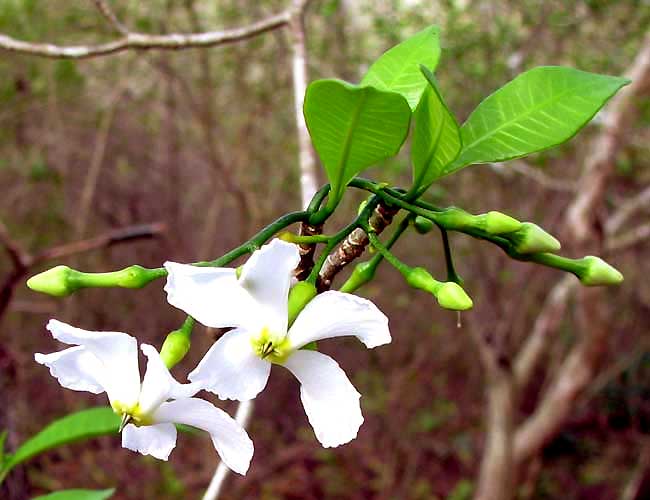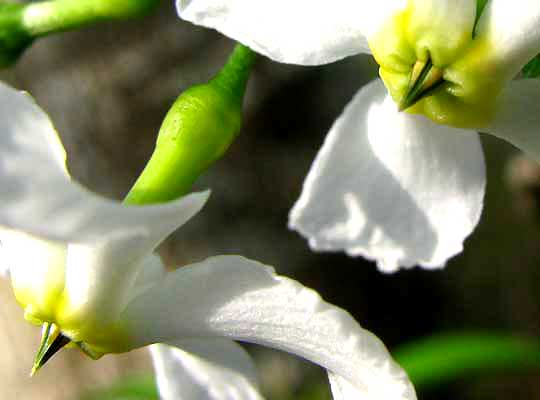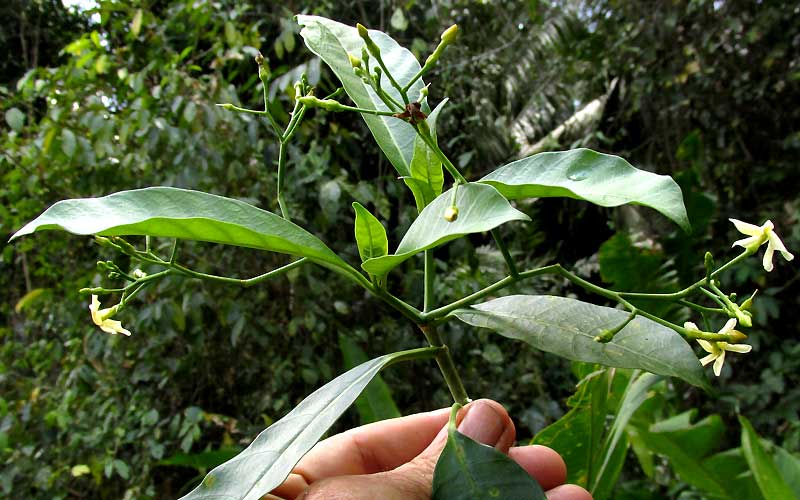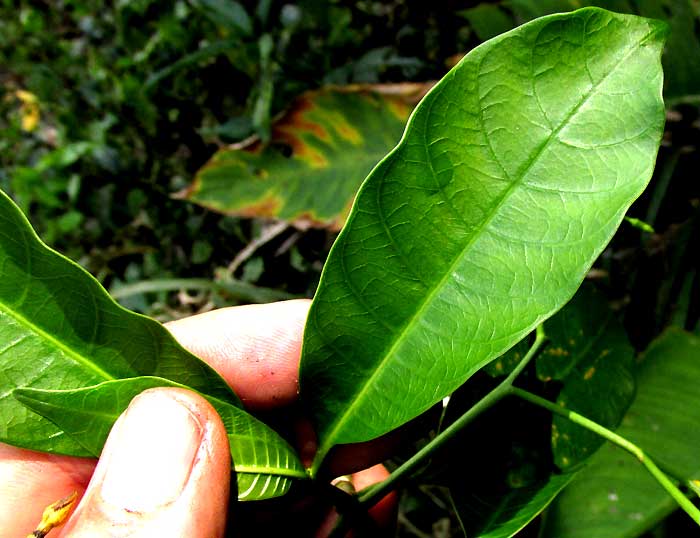Excerpts from Jim Conrad's
Naturalist Newsletter

from the April 25, 2010 Newsletter issued from Hacienda Chichen Resort beside Chichén Itzá Ruins, central Yucatán, MÉXICO; limestone bedrock, elevation ~39m (~128ft), ~N20.676°, ~W88.569°
"DOG JASMINE"
One of the prettiest-flowering trees these days is one without a decent English name. I call it "Dog Jasmine" because in Spanish sometimes it's called Jazmín de Perro, which translates to that. Actually, because its future fruit will be a double-bag affair, the most commonly used Spanish names translate to such things as "Pig Balls," "Bull Balls," etc. However the fruits are a long time off and the sweet-smelling flowers deserve a more elegant name, so, "Dog Jasmine." It's TABERNAEMONTANA AMYGDALIFOLIA, and you can see inch-broad flowers and freshly emerging, opposite leaves above.
This is a member of the same family in which we find Mandevilla vine, Oleander, Periwinkle and Frangipani, the Apocynaceae. Members of that family usually exude "milk," or white latex, when injured, and so does "Dog Jasmine." Often the latex of plants in this family is poisonous or medicinal. In Mexico sometimes Dog Jasmine's latex has been used as a laxative and a purgative, but those "cures" might just be the body's reaction to a mild poisoning. Las Plantas Medicinales de México urges caution with the plant.
An interesting feature of the flower is how the five stamens are inserted at the mouth of the corolla tube, with their pointed, baglike, pollen-producing anthers poking from the opening like little noses, as shown below:

Another Tabernaemontana, T. citrifolia, is very similar and is reported from the Yucatan, but its anthers remain hidden in the corolla tube -- they're " included" instead of "exserted" as these are.
In the context of our current burgeoning "spring," Dog Jasmine surrounded by the forest's diffuse greenness creates an impression much like the North's Flowering Dogwoods, except that Dog Jasmine trees, about the size of a northern dogwood, is more delicate-looking and somehow even more evocative of new beginnings.
notes from an April 2, 2019 camping trip in Ceibal Archaeological Park about 15kms east of Sayaxché in Petén department, GUATEMALA
"PIG BALLS TREE"
Along a trail connecting ruins inside the park I passed a small tree about 3m tall (10ft) bearing the immature fruits shown below:

Several woody plants produce double fruits like this and among the local people the fruits always produce a laugh, and are called something like Cojones de Puerco, "Pig Balls," with the name of the animal changing from place to place. Usually such pairs of fruits are produced by members of the Dogbane Family, the Apocynaceae, and that was the case this time, too, made clear by the flowers, shown below:

Individual flowers twisted their corolla lobes in a spiraling fashion, shown below:

I think that the above blossom is a little immature, for its anthers are not yet extended beyond the corolla's mouth, and the lobes are not fully expanded in width. The glossy, leathery leaves that issue white latex when injured were typical of the family, too, shown below:

Tabernaemontana amygdalifolia occurs from Mexico and the Caribbean south through Central America into northern South America.
I read that in the Yucatan, an infusion of the leaves of Tabernaemontana amygdalifolia sometimes is taken as a laxative.